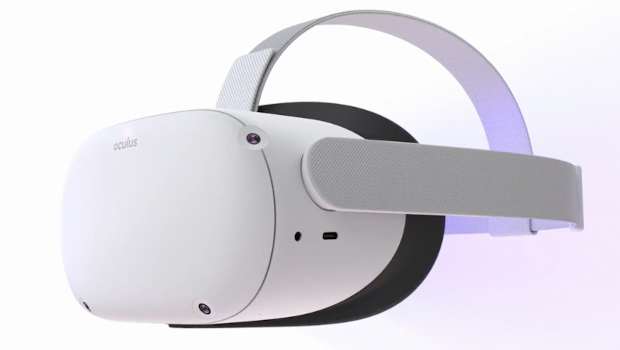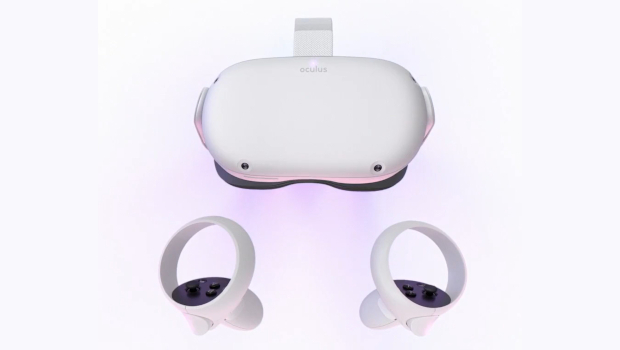
Oculus launches Quest 2 VR headset, unveils virtual office
The Oculus Quest 2 is here. Announced Wednesday at Facebook Connect, it builds upon the untethered appeal of Facebook’s original Oculus Quest, whose freedom of movement came with performance limitations. Oculus Quest 2 brings important improvements – most notably, 2K displays running at 90Hz.
While many details of Facebook’s new Oculus Quest 2 headset leaked out early, what we didn’t know was the price: $299, a significantly cheaper option versus the $399 Oculus charged for the Facebook Quest. Mark Zuckerberg, the chief executive of Facebook, introduced the Quest 2 by identifying the $299 price point. But there will apparently be two models: the $299 model with 64Gb of storage, and a more expensive $399, 256GB model, according to Road2VR.com, which received a briefing on the Quest 2 news. Preorders will begin in the US on 13 October.
The original Quest supported full position-tracking and room-scale VR, all tracked by four cameras at each edge of the original headset. With the Quest 2, Oculus has taken that a step further: Those cameras can now track your hand, so that you’ll theoretically be able to ditch the controllers in certain games.

The Quest platform defines its play space using its Guardian technology, which allows you to ‘draw’ a rectangle on the floor to define the boundaries of the space. The original Quest defined up to five boundaries, which it remembered using objects as landmarks in your house. One of the original Quest’s limitations was that it had some trouble differentiating objects from the shadows they cast, which led to some odd anomalies. Nothing appears to have changed here.
The original Oculus Quest was based on Qualcomm’s Snapdragon 835 chipset, which delivered 2560×1440 resolution (compared to the original Quest’s 2160×1200 output), at 72 frames per second (fps). At the time, Qualcomm was using the 835 in phones as well.
Last December, however, Qualcomm debuted the Snapdragon XR2 platform specifically for mixed reality. The Quest 2 takes advantage, with two ‘nearly 2K’ displays that run at 1832×1920 per eye at 90Hz, according to Road2VR.com. According to Zuckerberg, the Quest 2 uses a single LCD display. (Qualcomm said earlier that the XR2 could deliver 3000×3000 per eye, at 90fps, or 2.5Kx2.5K at 120Hz. HDR10+ was also supported.) For those interested in the performance of the tethered Oculus Rift (without actually buying one), Oculus has included an Oculus Link cable to pipe content over from a gaming PC.
Facebook also addressed some of the biggest complaints of the first Oculus Quest. For one thing, the original Quest offered 100Gb or so of available storage after the OS was taken into account. With the Quest 2, the storage has been boosted to a maximum of 256Gb. Likewise, the available memory has been upgraded from 4Gb to 6Gb in the Oculus Quest 2.
With all of the performance upgrades, how will the Quest 2 feel? We won’t know until we test it, but Oculus is also suggesting that the Quest 2 will be more comfortable to wear, with an upgraded strap. It’s also 10% lighter, at 503g. Oculus has left battery life unchanged at about 2.5 hours for the Quest 2 itself. You’ll still need AA batteries to power the two standalone controllers.
A number of games will be optimised for use with the Quest 2, including multiplayer versions of Beat Saber; Population One, a VR battle-royale game, and Jurassic World: Aftermath, and two out-of-the-blue surprises: VR-specific versions of Assassins’ Creed and Splinter Cell.
With millions of users working and studying from home, the Oculus Quest 2 should find a receptive market. Still, Facebook’s new VR headset will have to convince players to ignore the upcoming launches of the Microsoft Series S/X consoles as well as the Sony PlayStation 5. At least the Quest 2 will have a few years before Facebook begins mandating a Facebook account to use it.
Infinite Office
Facebook also debuted a concept called Infinite Office, a experiment that will move the concept of multiple displays into virtual reality when it debuts this winter.
Facebook will even get around the problem of typing in VR – when, otherwise, you wouldn’t be able to see your hands – by partnering with Logitech on a keyboard. The Infinite Office keyboard will exist in the real world and be seen by the Oculus Quest 2 hardware as well.
Facebook’s idea is that productivity should exist in the virtual space, as well as in the real world. With so many people working from home, they may not have a large physical workspace upon which they can mount many monitors – which improves productivity for most people. By placing those monitors in a virtual space, Infinite Office allows users to surround themselves with screens, and thus accomplish more during their workday.
Facebook isn’t saying much more about INfinite Office bar plans to roll it out a limited beta this winter, and it disclosed a partnership with Spatial, a collaborative AR platform.
Causing a Rift with PCs
A longstanding criticism of VR is the continued reliance on PCs. Facebook is working to remove that issue with the Quest 2 but the flagship Rift S isn’t so far behind.
”We’re going to focus on standalone VR headsets moving forward,” the company said. “We’ll no longer pursue PC-only hardware, with sales of Rift S ending in 2021. That said, the Rift Platform isn’t going anywhere. In fact, we’ve seen significant growth in PC VR via Oculus Link, and the Rift Platform will continue to grow while offering high-end PC VR experiences like Lone Echo II and Medal of Honor: Above and Beyond well into the future.”
It’s unclear what Facebook and Oculus plan with the Rift platform, though it appears that the company sees the Oculus Link Cable as the bridge between PC-powered VR and the standalone world. The company’s web page says the cable offers the opportunity to play “the best of both worlds,” and that the cable “unlocks the power of your PC to add stunning graphics and heart-pounding gameplay to your VR experiences”.
It’s unclear, though, what this announcement will mean for developers who had designed games that were optimised for the Oculus Rift platform.
IDG News Service






Subscribers 0
Fans 0
Followers 0
Followers